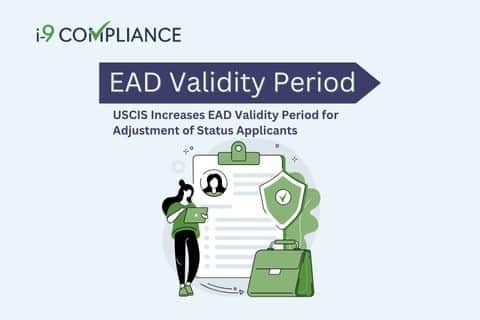USCIS Increases EAD Validity Period for Adjustment of Status Applicants

October 26, 2023
The U.S. Citizenship and Immigration Services (USCIS) recently announced that it would increase the maximum validity period for several employment authorization documents (EADs). The USCIS took this action to help foreign national workers and their employers and to reduce the ongoing processing EAD backlog. This change will increase the maximum period for affected categories to five years, significantly reducing the burden on employers and workers.
This news will primarily affect those with pending applications for Adjustment of Status. Adjustment of Status is the last step in acquiring a lawful permanent residence. Unfortunately, this process can take several years for processing to complete. Processing for Adjustment of Status at several large processing centers can take two to three years.
Beneficiaries can file for an EAD during the Adjustment of Status process. EADs act as work authorizations, allowing them to work without work visas, such as the H-1B. Acquiring an EAD has proven crucial for many beneficiaries waiting for their Adjustment of Status.
Previously, Adjustment of Status applicants’ EADs had a maximum of two years. This time limit made it crucial for them to renew their EADs. However, renewing the EADs meant their employers had to reverify their employment authorization. The beneficiaries risked gaps in employment if issues occurred during the renewal process.
The USCIS hopes this new rule will alleviate the burdens beneficiaries and their employers face during renewal. In addition, this rule would reduce the number of renewal applications it must process. This reduction would allow the agency to focus more resources on the growing EAD backlogs.
As of September 27, 2023, interested parties may begin filing for these EADs. Eligible categories include asylees, refugees, and applicants for suspension of deportation or cancellation of removal. The USCIS also updated its guidance for other noncitizen categories.
These categories include the employment-authorized incident to status or circumstance. Others who may qualify include those with Arrival/Departure records (Form I-94) for the employment eligibility verification (Form I-9) process. These records count as List C documents that prove their work authorization. As such, beneficiaries may present it with a List B document that proves their identity to complete the I-9 process.
Employers should remain attentive to issues such as these, which can impact Form I-9 compliance. One way to stay abreast of these and other developments is to incorporate an electronic I-9 management system. This system can guide HR personnel through every step of the verification process and provide reminders when further action is required.
Learn more about automating your employment eligibility verification and ensuring compliance with I-9Compliance.